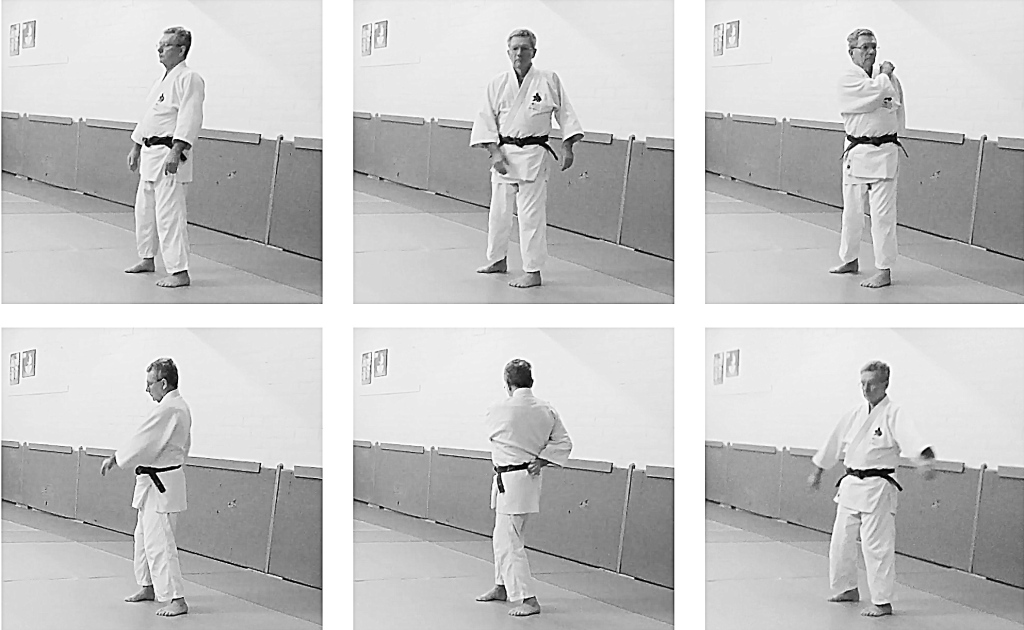Workshop 14-16 February 2020
This workshop was build around basic aikido movements and the overlapping elements of different methods of aikido.
- Solo training: warming up, unsoku ho and tandoku undo
- Partner training: 7-hon no kuzushi – using the central line or seichusen
- Partner training: 2 aspects of tekubi waza – hineri & gaeshi
- Taijū no ido & Taijū no dendō or “using body weight”
Partner training is discussed in another blog-post.
Your personal solo-training
Solo-training is an integral part of martial art training. The difficulty is the absence of the instructor or coach to encourage you. Most people have always an excuse for not doing solo-training during their spare time.
Personal solo-training can be practised any free-time and can give you a lot of benefits.
Benefits of solo-training
Solo-training is your personal tool to create skills usefull during dojo-training. You can use exercises dvelopped by yourself or you can use syllabus items supplemented with your ideas. Of course beginners start better with the syllabus basic solo-exercises. During dojo-training, your coach or instructor will help you with problems and difficulties.
An important benefit of solo-training, you can choose yourself which movement you like to improve. Solo-training during your spare time is not dependent on the opening hours of the dojo. You only need some space were you can practise your solo-exercises. Only you are responsable for your practise time.
Warming-up
There are numerous versions of warming-up. If you just want to do some exercises to change from a sedentary moment to a more dynamic moment, warming-up will focus on moving major body joints. Some teachers even say there is no warming-up needed, because Budo movements can be used for warming-up.
A simple method for a short warming-up

- Knees/Ankle rotation
- Hip rotation
- Waist rotation
- Body rotation
- Shoulder/Elbow rotation
- The Wave
***

Knees/Ankle rotation
Turning of the knees and ankles. For example 10x left and right.
***

Hip rotation
Turning the hips horizontally. For example 10x left and right.
***

Waist rotation
Bend knees and keep together.Turning the waist left & right 20X
***

Body rotation
Body rotation along the body axis. 20X
***

Shoulder/Elbow rotation
This is a “kyokotsu” exercise
***
The Wave
A 3D exercise with “undulation” patern.

***
Unsoku-ho or foot movements patterns
Unsoku-ho in Tomiki Aikido is based upon Judo foot movements. When you only practise these patterns, you will find out the restrictive character of these judo foot movements pattern.

Organising another unsoku-ho for a more traditional aikido practise includes turning actions generated by turning “hara” movements.
Extended unsoku-ho can be included into basic tandoku undo.
- Ashi no korobi (rolling feet)
- Tsugi Ashi (short distance)
- Ayumi ashi (stepping)
- De-mawari (forward turning step)
- Hiki-mawari (backward turning step)
- Tentai (180° turning without stepping)
Tandoku Undo
Almost every Aikido group has some kind of solo-training and Tomiki Aikido is no exception. Tomiki Aikido tandoku undo will vary according the organisations syllabus. As beginner you just stick to the syllabus.
Tomiki Aikido Tandoku undo is created around 3 kind of basic movements already discussed earlier.
- Uchi & tsuki waza: striking movements
- Tegatana Go-dosa: 5 handblade movements
- Unsoku-ho: foot patterns
Athough there is a certain sequence in the solo-training, you don’t have to practise the exercises as prediscribed by the syllabus. If you find out you need some time fo improve a certain skill, you can practise only those exercises which include the pattern of the skill.
- Unsoku-ho
- Shomen uchi/tsuki
- Uchi/soto mawashi
- Uchi/soto gaeshi
- Uchi mawashi – de-mawari
- Soto mawashi – hiki-mawari
- Ko-mawashi – tentai
- O-mawashi – de-mawari/hiki-mawari

3 thoughts on “Tandoku Undo – Solo training”